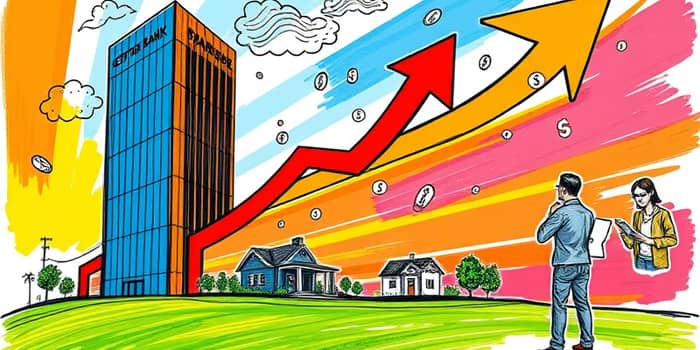
In mid-2025, the global financial landscape has shifted under the weight of historically high compared to past two decades interest rates. Economic actors—from households to major corporations—are adapting to a reality where borrowing is no longer inexpensive. This article explores how recent policy moves by the Federal Reserve have ushered in a new paradigm for lending, reshaping credit markets and redefining affordability.
As of June 2025, the Federal Reserve’s target federal funds rate stands at 4.25%–4.50%, following three modest rate cuts in 2024 but no adjustments in the first half of this year. Despite whispers of two rate cuts in late 2025, uncertainty surrounding inflation trends, tariffs, and geopolitical tensions has tempered market expectations. The last change—a 0.25 percentage point reduction in December 2024—ended a streak of aggressive hikes that began in early 2022.
This higher-for-longer rate environment contrasts sharply with the near-zero levels of 2020–2021. Consumer sentiment surveys reveal growing caution: many households delay major purchases, anticipating more clarity on borrowing costs before committing to big-ticket spending.
The federal funds rate influences the cost of funds for banks and institutions, cascading into rates for consumer and business loans. When the Fed lifts its policy rate, financial institutions pass on higher borrowing costs to customers, tightening credit conditions.
Key transmission channels include:
The cumulative impact curbs demand for credit, aligning with the Fed’s goal of cooling inflationary pressures.
Rate adjustments have varied effects across lending markets. The following table summarizes the mid-2025 landscape:
By January 2025, 30-year fixed-mortgage rates exceeded 7% for the first time since mid-2024—a sharp reversal from the historic 2.65% lows of January 2021. Higher rates translate into heftier monthly payments, regardless of slight downturns in home prices. For example, financing a $417,000 home at 6.8% yields a payment of $2,788, while a $407,000 purchase at 7.8% jumps to $2,971 per month.
Consequently, home sales have decelerated and listings linger longer on the market. In April 2025, the median time-on-market reached 50 days, compared with 45 days a year earlier. Meanwhile, homeowners with existing low-rate mortgages hold off on refinancing, further constricting market turnover.
The Federal Reserve’s rate decisions serve dual—and sometimes competing—goals. Principally, higher rates aim to:
Conversely, rate cuts are deployed to stimulate growth in low-inflation or recessionary environments. Through direct impacts on bank funding costs and indirect effects on investor expectations, policy shifts ripple through bond yields and consumer confidence alike.
Consumers now confront steeper rates on mortgages, auto loans, credit cards, and personal financing. Higher monthly obligations force many families to postpone vacations, home improvements, or vehicle purchases. Limited access to affordable credit may also exacerbate inequality, as lower-income borrowers find threshold rates out of reach.
Businesses mirror this caution. Small firms—especially those reliant on bank credit—delay equipment investments, lease expansions, or hiring initiatives when debt service costs rise.
In response to tightening monetary policy, lenders have adopted tightening underwriting standards and practices. Minimum credit scores climb, required down payments increase, and some institutions cap loan-to-value ratios. However, heightened competition for quality borrowers persists, encouraging consumers to shop multiple lenders for best rates and potentially save hundreds of dollars annually.
With the Fed meeting scheduled for July 29–30, 2025, markets eagerly await guidance on the rate trajectory. Variables clouding the outlook include the path of inflation, emerging geopolitical tensions, and the resilience of consumer demand. Analysts debate whether the central bank will maintain a cautious stance or pivot more aggressively toward cuts.
Pre-pandemic rates were generally moderate—higher than 2020 lows but below today’s thresholds. Emergency cuts in 2020–2021 created an ultra-low-rate era, driving surges in refinancing and asset prices. The rapid 2022–2023 tightening cycle represents a watershed moment, arguably cementing a structurally more expensive in medium-to-long term lending regime.
As credit costs stabilize at elevated levels, borrowers and lenders alike are redefining what constitutes “normal” financing conditions. The emerging consensus suggests that ultra-cheap credit may be an anomaly of the pandemic years, with the current environment setting fresh benchmarks for affordability and risk management.
In this evolving landscape, stakeholders must remain vigilant. Monitoring central bank communications, economic indicators, and market sentiment will be crucial for navigating uncertainties that lie ahead. Ultimately, understanding and adapting to this new paradigm for lending will determine success—for consumers planning life’s milestones and businesses charting paths to growth.
References













